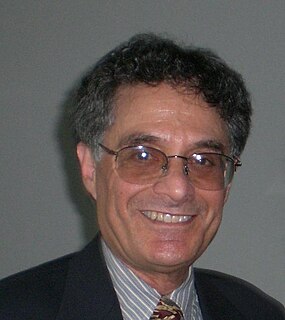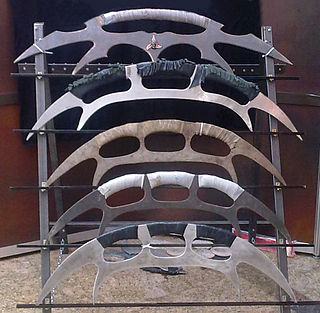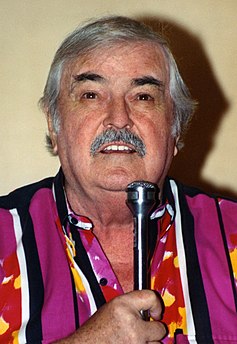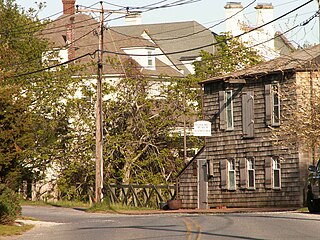
Worf, son of Mogh is a fictional character in the Star Trek franchise. He appears in the television series Star Trek: The Next Generation(TNG) and seasons four through seven of Star Trek: Deep Space Nine(DS9) as well as the feature films Star Trek Generations (1994), Star Trek: First Contact (1996), Star Trek: Insurrection (1998), and Star Trek: Nemesis (2002). Worf is the first Klingon main character to appear in Star Trek, and has appeared in more Star Trek franchise episodes than any other character. He is portrayed by actor Michael Dorn.

Martok, son of Urthog is a recurring character in Star Trek: Deep Space Nine, played by actor J. G. Hertzler.

Marc Okrand is an American linguist. His professional work is in Native American languages, and he is well known as the creator of the Klingon language in the Star Trek science fiction franchise.

Kahless the Unforgettable is a fictional character in the Star Trek universe. He is portrayed in Star Trek: The Original Series by Robert Herron and in Star Trek: The Next Generation by Kevin Conway.

The bat'leth is a double-sided scimitar/hook sword/deer horn knives hybrid-edged weapon with a curved blade, four points, and three handholds on the back. It was designed and created by Star Trek: The Next Generation visual effects producer Dan Curry for the Star Trek franchise, where it is the characteristic melee weapon of Klingons. Curry has called the bat'leth "one of the iconic images associated with the show." It has spawned a smaller version, which became known as the “mek'leth;” in Klingon, this is written meqleH. Bat'leths have become an enduring symbol of the franchise among fans, and they are occasionally referenced in other media.
"Errand of Mercy" is the twenty-seventh episode of the first season of the American science fiction television series Star Trek. Written by Gene L. Coon and directed by John Newland, it was first broadcast on March 23, 1967. It was the first episode in which the Klingons appeared.

In the fictional Star Trek universe the Klingon High Council is the supreme ruling body of the Klingon Empire. The council meets at the Great Hall of the First City of the Klingon Empire on the planet Qo'noS.
The Star Trek canon is the set of all canonical material in the Star Trek universe. The official Star Trek website defines canon as comprising the television series Star Trek: The Original Series, Star Trek: The Animated Series, Star Trek: The Next Generation, Star Trek: Deep Space Nine, Star Trek: Voyager, Star Trek: Enterprise, Star Trek: Discovery, and the films in the franchise. Editorials on the Star Trek website acknowledged that this definition is not set in stone, but that the notion of canon in Star Trek is fluid, open to interpretation and debate.

The Klingon Dictionary (TKD) is a book by Marc Okrand describing the Klingon language. First published in 1985 and then again with an addendum in 1992, it includes pronunciation, grammar and vocabulary. It has sold more than three hundred thousand copies and has been translated into five languages.
Rightful Heir is the 149th episode of the American science fiction television series Star Trek: The Next Generation. The 23rd episode of the sixth season.
Klingon culture describes the customs and practices of Klingons in the fictional Star Trek universe.

"The Sword of Kahless" is the 81st episode of the American science fiction television series Star Trek: Deep Space Nine, the ninth of the fourth season. It originally aired on November 20, 1995 in broadcast syndication. The story was created by Richard Danus and was turned into a teleplay by Hans Beimler. The episode was directed by Star Trek: The Next Generation alumnus LeVar Burton, and featured the return of John Colicos as Kor. Colicos had first appeared as Kor in the Star Trek: The Original Series episode "Errand of Mercy", and had previously appeared in this series in the episode "Blood Oath".
Klingon alphabets are fictional alphabets used in the Star Trek movies and television shows to write the Klingon language.
The Klingon Language Institute (KLI) is an independent organization located in Flourtown, Pennsylvania, United States. Its goal is to promote the Klingon language and culture.

A Klingon Christmas Carol is the first play to be performed entirely in Klingon, a constructed language first appearing in the Star Trek media franchise. The play is based on the Charles Dickens novella, A Christmas Carol. A Klingon Christmas Carol is the Charles Dickens classic tale of ghosts and redemption, adapted to reflect the Klingon values of courage and honor, and then translated into Klingon, performed with English supertitles.
The grammar of the Klingon language was created by Marc Okrand for the Star Trek franchise. He first described it in his book The Klingon Dictionary. It is a nominative–accusative, primarily suffixing agglutinative language, and has an object–verb–subject word order. The Klingon language has a number of unusual grammatical features, as it was designed to sound and seem alien, but it has an extremely regular morphology.

The Klingon Way: A Warrior's Guide is a 1996 book by the linguist Marc Okrand that was published by Pocket Books. The Klingon Way is a collection of proverbs and sayings in the constructed language of Klingon, ascribed to the Klingon race and Klingon culture in the fictional Star Trek universe. Okrand first began constructing the Klingon language in the 1980s when he was hired to produce Klingon dialogue for Star Trek III: The Search for Spock, going on to publish The Klingon Dictionary. The Klingon Way expanded the Klingon lexicon, and was followed by Klingon for the Galactic Traveler.
Klingon for the Galactic Traveler (KGT) is the third book written by Marc Okrand about the Klingon language. It was published in 1997.




















